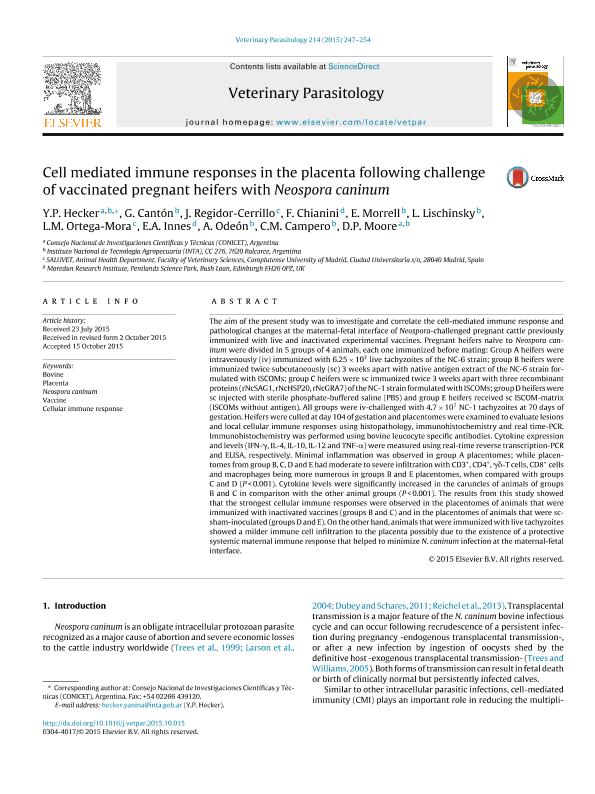Artículo
Cell mediated immune responses in the placenta following challenge of vaccinated pregnant heifers with Neospora caninum
Hecker, Yanina Paola ; Canton, German; Regidor Cerrillo, J.; Chianini, F.; Morrell, Eleonora Lidia
; Canton, German; Regidor Cerrillo, J.; Chianini, F.; Morrell, Eleonora Lidia ; Lischinsky, L.; Ortega Mora, L. M.; Innes, E. A.; Odeón, Anselmo Carlos; Campero, Carlos Manuel; Moore, Dadin Prando
; Lischinsky, L.; Ortega Mora, L. M.; Innes, E. A.; Odeón, Anselmo Carlos; Campero, Carlos Manuel; Moore, Dadin Prando
 ; Canton, German; Regidor Cerrillo, J.; Chianini, F.; Morrell, Eleonora Lidia
; Canton, German; Regidor Cerrillo, J.; Chianini, F.; Morrell, Eleonora Lidia ; Lischinsky, L.; Ortega Mora, L. M.; Innes, E. A.; Odeón, Anselmo Carlos; Campero, Carlos Manuel; Moore, Dadin Prando
; Lischinsky, L.; Ortega Mora, L. M.; Innes, E. A.; Odeón, Anselmo Carlos; Campero, Carlos Manuel; Moore, Dadin Prando
Fecha de publicación:
12/2015
Editorial:
Elsevier Science
Revista:
Veterinary Parasitology
ISSN:
0304-4017
Idioma:
Inglés
Tipo de recurso:
Artículo publicado
Clasificación temática:
Resumen
The aim of the present study was to investigate and correlate the cell-mediated immune response and pathological changes at the maternal-fetal interface of Neospora-challenged pregnant cattle previously immunized with live and inactivated experimental vaccines. Pregnant heifers naïve to Neospora caninum were divided in 5 groups of 4 animals, each one immunized before mating: Group A heifers were intravenously (iv) immunized with 6.25 × 107 live tachyzoites of the NC-6 strain; group B heifers were immunized twice subcutaneously (sc) 3 weeks apart with native antigen extract of the NC-6 strain formulated with ISCOMs; group C heifers were sc immunized twice 3 weeks apart with three recombinant proteins (rNcSAG1, rNcHSP20, rNcGRA7) of the NC-1 strain formulated with ISCOMs; group D heifers were sc injected with sterile phosphate-buffered saline (PBS) and group E heifers received sc ISCOM-matrix (ISCOMs without antigen). All groups were iv-challenged with 4.7 × 107 NC-1 tachyzoites at 70 days of gestation. Heifers were culled at day 104 of gestation and placentomes were examined to evaluate lesions and local cellular immune responses using histopathology, immunohistochemistry and real time-PCR. Immunohistochemistry was performed using bovine leucocyte specific antibodies. Cytokine expression and levels (IFN-γ, IL-4, IL-10, IL-12 and TNF-α) were measured using real-time reverse transcription-PCR and ELISA, respectively. Minimal inflammation was observed in group A placentomes; while placentomes from group B, C, D and E had moderate to severe infiltration with CD3+, CD4+, γδ-T cells, CD8+ cells and macrophages being more numerous in groups B and E placentomes, when compared with groups C and D (P < 0.001). Cytokine levels were significantly increased in the caruncles of animals of groups B and C in comparison with the other animal groups (P < 0.001). The results from this study showed that the strongest cellular immune responses were observed in the placentomes of animals that were immunized with inactivated vaccines (groups B and C) and in the placentomes of animals that were sc-sham-inoculated (groups D and E). On the other hand, animals that were immunized with live tachyzoites showed a milder immune cell infiltration to the placenta possibly due to the existence of a protective systemic maternal immune response that helped to minimize N. caninum infection at the maternal-fetal interface.
Palabras clave:
Bovine
,
Cellular Immune Response
,
Neospora Caninum
,
Placenta
,
Vaccine
Archivos asociados
Licencia
Identificadores
Colecciones
Articulos(CCT - MAR DEL PLATA)
Articulos de CTRO.CIENTIFICO TECNOL.CONICET - MAR DEL PLATA
Articulos de CTRO.CIENTIFICO TECNOL.CONICET - MAR DEL PLATA
Citación
Hecker, Yanina Paola; Canton, German; Regidor Cerrillo, J.; Chianini, F.; Morrell, Eleonora Lidia; et al.; Cell mediated immune responses in the placenta following challenge of vaccinated pregnant heifers with Neospora caninum; Elsevier Science; Veterinary Parasitology; 214; 3-4; 12-2015; 247-254
Compartir
Altmétricas



